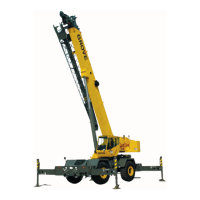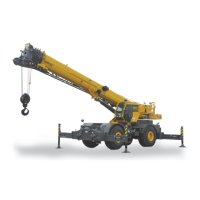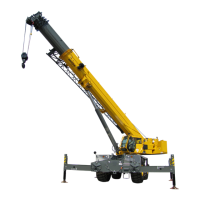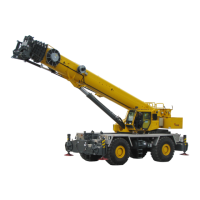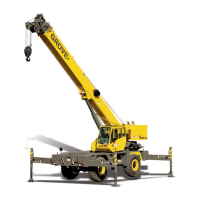HYDRAULIC SYSTEM RT880E SERVICE MANUAL
2-88 Published 11-10-2014, Control # 524-00
STEER CYLINDER
Description
The steer cylinders Figure 2-50 are mounted on the axles,
two cylinders on each axle. The front and rear steer cylinders
each have 3.5 in (8.89 cm) diameter bores. The front and
rear steer cylinders each have a retracted length of 26 in
(66.0 cm) from bushing center to bushing center. The front
and rear steer cylinders each have an extended length of
37.5 in (95.25 cm) from bushing center to bushing center.
Each cylinder has a stroke of 11.50 in (29.21 cm). A wiper
ring prevents foreign material from entering each cylinder. O-
rings and other seals prevent internal and external leakage.
The cylinder weighs approximately 44 lb (20 kg).
Maintenance
Disassembly
NOTE: Any maintenance requiring disassembly of the cyl-
inders should include replacement of all seals and
rings. A seal kit will supply the required items.
1. Secure the cylinder in a clean work area by use of
clamps or a chain vise to prevent rolling.
2. Retract the cylinder fully to avoid damaging the rod dur-
ing removal.
NOTE: Mark or note the piston and head relationship to the
rod and barrel.
3. Clean away all dirt from the head. Place protective pad-
ding around the rod near the head to prevent damaging
the chrome during head removal.
4. Position the rod mount with the ports facing down.
5. Using a means of collecting the oil, remove the port
plugs and allow cylinder to drain.
6. Turn the head counterclockwise with a spanner wrench
until the threads disengage.
7. With a hoist, extend rod slowly until the piston is free of
the barrel.
8. Place the rod assembly on a surface that will not dam-
age the chrome or allow the rod assembly to drop.
9. Cover the open end of barrel to avoid contamination.
10. Secure the rod assembly by clamping on the rod mount.
Do not clamp on the chrome surface.
11. Remove the locknut and slide the piston off over the
threads. Use a rubber mallet only if the piston will not
pull or turn off.
12. Remove the head from the rod by hand.
13. Remove the seal and wear ring from the outside of the
piston.
NOTE: Arranging discarded seals and rings in the order of
disassembly will aid in installation of new seals and
rings. Pay attention to how each seal and ring is
installed to avoid installing replacement seals and
rings improperly.
14. Remove the O-ring from the inside of the piston.
15. Remove the O-ring and backup ring from the outside of
the head.
16. Remove the wiper ring and rod seal from the inside of
the head.
Inspection
1. Inspect the rod. There should be no scratches or pits
deep enough to catch the fingernail. Pits that go to the
base metal are unacceptable. Chrome should be pres-
ent over the entire surface of the rod. If lack of chrome
on rod, the rod should be replaced.
2. Inspect rod for straightness. Determine if it can be
straightened or must be replaced.
3. Inspect the head. Visually inspect the inside bore for
scratching or polishing. Deep scratches are unaccept-
able. Polishing indicates uneven loading, and the bore
should be checked for out-of-roundness.
4. Inspect the piston. Visually inspect the outside surface
for scratches or polishing, Deep scratches are unaccept-
able. Polishing indicates uneven loading, and the diame-
ter should be checked for out-of roundness.
5. Inspect the barrel carefully for scoring, scratches and
pits. There should be no scratches or pits deep enough
to catch the fingernail. If barrel is scored, it must be
repaired or replaced.
6. Thoroughly rinse parts, allow to drain, and wipe with a
lint-free rag. Inspect all parts for serviceability.
WARNING
Do not use air pressure to remove the rod. Use only a
source of controlled hydraulic oil pressure if the rod is
hard to move.
CAUTION
Exercise extreme care when handling or setting down the
rod. Damage to the rod surface may cause unnecessary
maintenance and expense.
